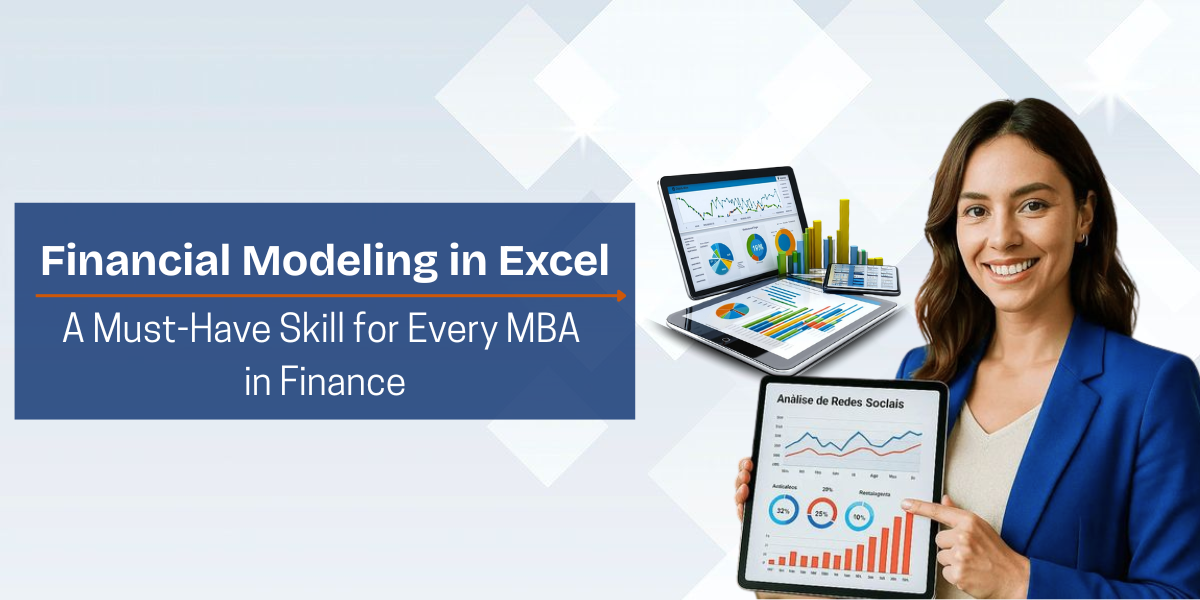In the data-driven world of finance, financial modeling in Excel is more than a software skill—it’s a critical thinking tool. It’s how corporate value is forecasted, risks are analyzed, and decisions are justified. For MBA students specializing in finance, mastering Excel-based modeling can make the difference between academic success and career excellence.
Why Excel-Based Financial Modeling Matters for MBA Students
- Universally Used in Finance Roles
Excel serves as the industry benchmark across investment banking, corporate finance, equity research, and financial planning due to its versatility and analytical power. Professionals worldwide rely on it to build valuation models, cash flow projections, and scenario analyses. - Combines Theory with Practical Application
Top MBA programs go beyond theory. Financial modeling enables real-world application of corporate finance principles—leveraging Excel’s formulas, functions, and macros to create dynamic forecasts and dashboards. - Boosts Confidence in Case Studies & Internships
During internships or competitions, students are expected to evaluate raw data and deliver insights. Solid Excel skills enable you to efficiently create models, analyze assumptions, and deliver insights backed by data. - Promotes Better Decision-Making
Effective modeling structures your thought process. You learn to separate inputs from calculations and outputs, link financial drivers clearly, and understand how decisions affect business outcomes.
Key Excel Techniques MBA Students Should Master
- Logical & Financial Functions: IF, SUMIF, IRR, NPV, XIRR, etc., to build accurate valuation models.
- Data Formatting & Visualization: Use conditional formatting, charts, and dashboards for clarity.
- Scenario & Sensitivity Analysis: Excel tools like Data Tables, What-If Analysis, and Goal Seek help evaluate different business outcomes.
- PivotTables and data handling: Organize extensive data sets to uncover key insights.
- Structured Modeling: Clearly define inputs, calculations, and outputs. Use consistent formulas and proper documentation.
Mastering these techniques builds both financial acumen and technical confidence—skills transferable to other platforms like Google Sheets, Power BI, or Tableau.
Effective Ways to Learn Financial Modeling During an MBA
- Workshops & Short-Term Certifications
Attend Excel modeling workshops offered by your college or external platforms. They help you build structured and scalable models. - Hands-On Classroom Projects
Group assignments and case studies simulate real-world financial decision-making. Use every opportunity to evaluate business performance with authentic financial data. - Online Courses
Platforms like Coursera and Udemy offer structured tutorials with case studies, helping you learn step-by-step. - Practice with Real Financial Reports
Download reports from listed companies and recreate financial statements, linking income statements to balance sheets and cash flows. - Mock Interview Tasks
Practice creating quick, accurate models under time pressure—essential preparation for interviews and internships.
Career Benefits of Excel Financial Modeling
- Better Placement Opportunities
Employers seek candidates who can build and interpret models without extensive training. You’ll stand out with job-ready skills. - Enhanced Analytical Credibility
Models demonstrate that your recommendations are backed by data and logic. This adds weight to your insights. - Career Flexibility
Whether in corporate finance, equity research, consulting, or startups, financial modeling is a core competency across domains.
IEMS B-School: Preparing Students for Financial Excellence
If you’re pursuing an MBA in Finance and want a strong foundation in real-world applications, IEMS B-School in Hubli offers a well-rounded program:
- Their curriculum blends finance theory with practical modeling and data analysis through projects, seminars, and computer labs.
- The college is known for its skilled faculty, solid placement support, and focus on professional readiness.
- With affordable fees and a dedicated placement cell, IEMS ensures students are industry-ready upon graduation.
IEMS B-School emphasizes core Excel and financial modeling skills as part of its finance specialisation—making it a great choice for hands-on learners.
Best Practices to Excel in Financial Modeling
| Step | What to Do |
| 1. Learn the Basics | Gain clarity on formulas, layout formatting, visual charts, and PivotTables. |
| 2. Understand Model Logic | Link revenues to costs, depreciation, and financing activities. |
| 3. Build Real Models | Use annual reports to simulate real projections and validate outputs. |
| 4. Use Scenario Tools | Compare “what-if” outcomes using sensitivity analysis. |
| 5. Review & Improve | Keep models clean, well-documented, and peer-reviewed. |
Why This Skill Sets You Apart
Excel modeling gives you a competitive edge in:
- Valuation & budgeting
- Making investment decisions
- Supporting mergers or capital strategies
- Communicating clear, data-backed insights
Most importantly, it teaches you how financial assumptions ripple through a business—making you a sharper decision-maker.
Conclusion
In the modern finance job market, Excel modeling is more than a skill—it’s an essential requirement. MBA students who invest time in mastering it become more confident, employable, and effective. If you’re aiming to build this strength in a supportive and practical environment, IEMS B-School in Hubli is a great choice.
It is consistently rated as the Best MBA college in Hubli, offering a balanced mix of theory, hands-on training, and placement support. By learning financial modeling at IEMS, you’re not just earning a degree—you’re equipping yourself with a lifelong career advantage.






